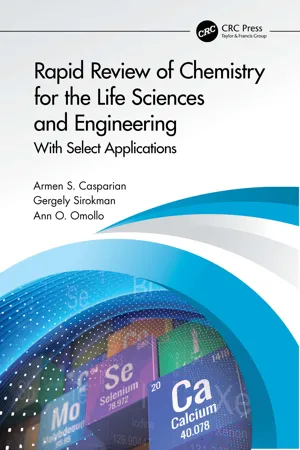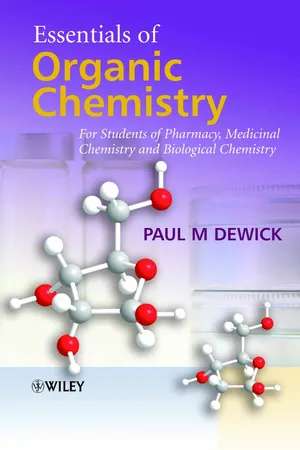Chemistry
Henderson-Hasselbalch Equation
The Henderson-Hasselbalch equation is a mathematical expression used to calculate the pH of a solution containing a weak acid and its conjugate base, or a weak base and its conjugate acid. It relates the pH of the solution to the pKa of the acid and the concentrations of the acid and its conjugate base. The equation is pH = pKa + log([A-]/[HA]), where A- is the conjugate base and HA is the weak acid.
Written by Perlego with AI-assistance
Related key terms
Related key terms
1 of 4
Related key terms
1 of 3
11 Key excerpts on "Henderson-Hasselbalch Equation"
- eBook - ePub
- Professor Rob Beynon, J Easterby(Authors)
- 2004(Publication Date)
- Taylor & Francis(Publisher)
It is time to introduce the Henderson–Hasselbalch equation. As with all equilibria, we can express the dissociation of a weak acid or base in terms of an equilibrium constant. For the rest of this section, we will develop a general solution for an acid HA, but illustrate with two examples, acetic acid and Tris, two commonly used buffers. Consider once again the equation that introduces the equilibrium constant K a. K a = [ H + ] [ A − ] [ HA ] K a is a constant, but is different for each buffer. For acetic acid/acetate it is 10 –4.76 M, for Tris it is 10 –8.1 M. What is the significance of these numbers, which seem to span a wide range, even judging by these two examples? To make things clearer, we shall modify this equation, using logarithmic transformation. First we rewrite the equation in a slightly different, but equivalent form: K a = [ H + ] [ A − ] [ HA ] ◊ The corresponding equations for acetic acid and Tris buffers are: K a = [ H + ] [ CH 3 COO − ] [ CH 3 COOH ] K a = [ H + ] [ Tris ] [ TrisH + ] Take log 10 of each side of the equation, and remembering that when we have two terms multiplied together, we add their. logarithms: log 10 K a = log 10 [ H + ] + log 10 [ A − ] [ HA ] Now, rearrange the equations to a different form, by swapping the two leftmost terms over, changing their signs as we do so: − log 10 [ H + ] = − log 10 K a + log 10 [ A − ] [ HA ] The left hand term should now be familiar: ‘−log 10 [H + ]’ is of course, our definition of pH (Chapter 1). Similarly, we recognise an equivalent construction in the term ‘−log 10 (K a)’ and can refer to this as p K a —we had already met this term briefly in Chapter 2. The equation now simplifies to: pH = p K a + log 10 [ A − ] [ HA ] ◊ In words: ‘The pH of a solution of a weak acid or base is given by the p K a plus the log (base 10) of the ratio of the concentrations of base to acid.’ This is the Henderson–Hasselbalch equation - eBook - ePub
Rapid Review of Chemistry for the Life Sciences and Engineering
With Select Applications
- Armen S. Casparian, Gergely Sirokman, Ann Omollo(Authors)
- 2021(Publication Date)
- CRC Press(Publisher)
follows: K h = [ H 3 O + ] [ NH 3 ] [ NH 4 + ] The value for K h is not given but can be found by applying the relationship K h = K w K b = 1.0 × 10 − 14 1.8 × 10 − 5 = 5.56 × 10 − 10 where K b is the value of the equilibrium base constant for NH 3 in H 2 O and is found in Table 4.1B. It is analogous to K a : NH 3 + H 2 O ⇋ NH 4 + + OH − The same strategy is then used as in Example 4.8. At equilibrium, then, [ H 3 O + ] = x [ NH 3 ] = x [ NH 4 + ] = 0.20 − x Therefore, 5.56 × 10 − 10 = (x) (x) 0.20 − x Use the same simplifying assumption as in Example 4.8, assume x ≪ 0.20 M, and solve. for x : x 2 = (0.20 M) (5.56 × 10 − 10) x = 1.1 × 10 − 5 Thus, [ H 3 O + ] = 1.1 × 10 − 5 M And, pH = − log [ H 3 O + ] = − log (1.1 × 10 − 5 M) = 4.96 The pH is less than 7.0, reflecting an acidic solution, as expected. Note: For the hydrolysis of an ion producing a basic or alkaline solution, K h = K w /K a. 4.9. Buffer Solutions and the Henderson–Hasselbalch Equation Buffer solutions are solutions that protect against large shifts in pH in the event of a shock due to the sudden addition of a strong acid or base. The pH of a buffer solution does, however, change slightly. Such a solution can be made with a combination of either of the following: A weak acid and its salt (conjugate base) A weak base and its salt (conjugate acid) Thus, acetic acid plus sodium acetate constitutes a buffer system, as does ammonium hydroxide plus ammonium chloride. To determine the pH of a buffer solution, the Henderson–Hasselbalch equation may be used. In the case of a weak acid (e.g., CH 3 COOH) and its conjugate base salt (e.g., NaCH 3 COO): pH = p K a + log [ conjugate base ] [ weak acid ] (4.8) The buffering capacity of a system refers to the amount of acid or base it can absorb before its pH changes - eBook - ePub
Essentials of Organic Chemistry
For Students of Pharmacy, Medicinal Chemistry and Biological Chemistry
- Paul M. Dewick(Author)
- 2013(Publication Date)
- Wiley(Publisher)
Taking negative logarithms of each side, this becomes orThis is referred to as the Henderson–Hasselbalch equation, and it is sometimes written asUsing this relationship, it is possible to determine the degree of ionization of an acid at a given pH.An immediate outcome from this expression is that the pK a of an acid is the pH at which it is exactly half dissociated. This follows fromBut when the concentrations of acid HA and conjugate base A− are equal, thenso thatThis means we can determine the pK a of an acid by measuring the pH at the point where the acid is half neutralized. As we increase the pH, the acid becomes more ionized; as we lower the pH, the acid becomes less ionized.For a base, K a is defined aswhich can be rearranged to give so that the Henderson–Hasselbalch equation is written or, as previouslyAgain, we can see that the pK a of a base is the pH at which it is half ionized. As we increase the pH, the base becomes less ionized; as we lower the pH, the base becomes more ionized.A further useful generalization can be deduced from the Henderson–Hasselbalch equation. This relates to the ratio of ionized to non-ionized forms as the pH varies. A shift in pH by one unit to either side of the pK a value must change the ratio of ionized to non-ionized forms by a factor of 10. Every further shift of pH by one unit changes the ratio by a further factor of 10.Thus, for example, if the pK a of a base is 10, at pH 7 the ratio of free base to protonated base is 1:103 . An acid with pK a 2 at pH 7 would produce a ratio of acid to anion of 105 :1.Box 4.6 Calculation of percentage ionizationUsing the Henderson–Hasselbalch equation, we can easily calculate the amount of ionized form of an acid or base present at a given pH, provided we know the pK a .For example, consider aqueous solutions of acetic acid (pK a 4.75) first at pH 4.0 and then at pH 6.0. Sinceat pH 4.0 ThusIf we consider [A− ] = I , the fraction ionized, then [HA] is the fraction non-ionized, i.e. 1 − I , and I /(1 − I ) = 0.18, from which I - eBook - ePub
- Linda Costanzo(Author)
- 2021(Publication Date)
- Elsevier(Publisher)
− form.The body fluids contain a large variety of buffers, which constitute an important first defense against changes in pH. Robert Pitts demonstrated this buffering capacity experimentally by injecting 150 mEq of H+ (as hydrochloric acid, HCl) into a dog whose total body water was 11.4 L. In a parallel experiment, Pitts added 150 mEq of H+ to 11.4 L of distilled water. In the dog, the addition of H+ caused the blood pH to decrease from 7.44 to 7.14—the dog was acidemic but alive. In the distilled water, addition of the same amount of H+ caused the pH to drop precipitously to 1.84, a value that would have been instantly fatal to the dog. Pitts concluded that the dog’s body fluids contained buffers that protected its pH from the addition of large amounts of H+ . The added H+ combined with the A− form of these buffers, and a strong acid was converted to a weak acid. The decrease in the dog’s body fluid pH was minimized, although not totally prevented. The distilled water contained no buffers and had no such protective mechanisms.Henderson-Hasselbalch Equation
The Henderson-Hasselbalch Equation is used to calculate the pH of a buffered solution. This equation is derived from the behavior of weak acids (and bases) in solution, which is described by the kinetics of reversible reactions:HA⇄K 2K 1H ++A −The forward reaction, the dissociation of HA into H+ and A− , is characterized by a rate constant, K1 , and the reverse reaction is characterized by a rate constant, K2 . When the rates of the forward and reverse reactions are exactly equal, there is a state of chemical equilibrium, in which there is no further net change in the concentration of HA or A− . As shown here, the law of mass action - eBook - ePub
- Peter Kam, Ian Power(Authors)
- 2015(Publication Date)
- CRC Press(Publisher)
K) of the substance.P H SYSTEMH+ ion concentration may be measured in two ways: directly as concentrations in nanomoles per litre or indirectly as pH. pH is defined as the negative logarithm (to the base 10) of the concentration of hydrogen ions. The pH is related to the concentration of H+ as follows:pH = log101[H +]pH = log10[H +]H +=10− pHpH = p K + log base/acidTable 8.1 Relationship between pH and hydrogen ion concentrationpH Hydrogen ion concentration (nmol/L) 7.7 20 7.4 40 7.3 50 7.1 80 It is important to note that pH and hydrogen ion concentration [H+ ] are inversely related such that an increase in pH describes a decrease in [H+ ] (Table 8.1 ). However, the logarithmic scale is nonlinear and, therefore, a change of one pH unit reflects a 10-fold change in [H+ ] and equal changes in pH are not correlated with equal changes in [H+ ]. For example, a change of pH from 7.4 to 7.0 (40 nmol/L [H+ ] to 100 nmol/L [H+ ]) represents a change of 60 nmol/L [H+ ], although the same pH change of 0.4, but from 7.4 to 7.8 (40 nmol/L [H+ ] to 16 nmol/L [H+ ]), represents a change of only 24 nmol/L [H+ ].BUFFERSA buffer is a solution consisting of a weak acid and its conjugate base, which resists a change in pH when a stronger acid or base is added, thereby minimizing a change in pH. The most important buffer pair in extracellular fluid (ECF) is carbonic acid (H2 CO3 ) and bicarbonate (HYDROGEN ION BALANCEHCO 3 −). The interaction between this buffer pair forms the basis of the measurement of acid–base balance.Cellular hydrogen ion turnover can be described in terms of processes that produce or consume H+ ions in the body (Table 8.2 ). The total daily H+ - eBook - ePub
- David G. Watson(Author)
- 2020(Publication Date)
- Elsevier(Publisher)
In the case of a weak acid, it is the protonated form of the acid that is un-ionized, and, as the pH falls, the acid becomes less ionized. For a base, the Henderson–Hasselbalch equation is written as follows: For example, when ammonia (p K a 9.25) is in a solution at pH 9.25, the Henderson–Hasselbalch equation can be written as follows: Ammonia is 50% ionized at pH 9.25. In this case, it is the protonated form of the base that is ionized, and, as the pH falls, the base becomes more ionized. Self-test 2.4 Calculate the percentage of ionization of ammonia at (i) pH 8.25 and (ii) pH 10.25. An alternative way of writing the expression giving the percentage of ionization for an acid or base of a particular p K a value at a particular pH value is: Ionization of drug molecules The ionization of drug molecules is important with regard to their absorption into the circulation and their distribution to different tissues within the body. The p K a value of a drug is also important with regard to its formulation into a medicine and to the design of analytical methods for its determination. Calculation example 2.1 Calculate the percentage of ionization of the drugs shown in Fig 2.1 at pH 7.0. Fig. 2.1 Ionization of a basic and an acidic drug. Diphenhydramine This drug contains one basic nitrogen, and, at pH 7.0, its percentage of ionization can be calculated as follows: Ibuprofen This drug contains one acidic group, and, at pH 7.0, its percentage of ionization can be calculated as follows: Self-test 2.5 Calculate the percentage of ionization of the following drugs, which contain one group that ionizes in the pH range 0–14, at the pH values of (i) 4 and (ii) 9. Buffers Buffers can be prepared from any weak acid or base and are used to maintain the pH of a solution in a narrow range - eBook - ePub
- Camillo Peracchia, Nasr H. Anaizi(Authors)
- 0(Publication Date)
- Bentham Science Publishers(Publisher)
This relationship can also be expressed using the Henderson-Hasselbalch (HH) equation (Eq. 3):where pH = -log[H+ ] and pKa = -logKa . For acetic acid, pKa = 4.75. This equation shows the direct relationship between pH and the ratio of the un-protonated to protonated forms of the acid. The level of protonation of acid as a function of the pH of the solution is illustrated in Fig. 2 . The pKa of 4.75 corresponds to a level of 50%. Thus, the pKa value is the same as the value of the pH of the solution at which protonated and un-protonated forms of the acid exist in equal concentrations. The pKa value of an acid is inversely related to its strength; the lower the pKa the stronger is the acid.Figure 2)Relationship between the dissociation status of acetic acid and the pH of the solution. When pH is about 4.76, which corresponds to the pKa of acetic acid, the two forms exist in identical amounts, [Acetic Acid] = [Acetate]. Adapted from:http://www.shimadzu.com/an/hplc/support/lib/lctalk/29/29intro.htmlBuffering
Buffers prevent or minimize the change in the activity of free protons (Δ[H+ ]), i.e. in the of the solution resulting from addition of acid or base. Fig. 3 compares the pH in pure water and in a buffer solution as HCl is added. A buffer pair is made up of a weak acid and its conjugate base. Ideally, the pKa of this buffer system should be equal or close to the desired pH of the solution. The addition of 100 mEqs of HCl to one liter of water containing 200 mEqs of acetate ion causes conversion of about half the acetate to acetic acid, thereby neutralizing much of the added H+ ion and minimizing Δ[H+ ] (i.e., buffering the pH). In a buffer system composed of HA and A- , the un-dissociated acid (HA) protects the pH of the solution against the addition of bases (or OH- ) while the conjugated base (A- ) guards against the addition of acid (H+ - eBook - ePub
Aquatic Chemistry
Chemical Equilibria and Rates in Natural Waters
- Werner Stumm, James J. Morgan(Authors)
- 2012(Publication Date)
- Wiley(Publisher)
equation iii . The following results obtain:Approximate Mathematical Expressions We can examine the linear equations for the exact solution for chemically justified approximations, which might simplify the solution. These approximations can then be checked to see if they are acceptable. For example, a solution of boric acid must yield [H+ ] > [OH− ], and equation iva might be approximated by [H+ ] = [B− ], and algebraic combination with the remaining equations yields a quadratic expression for [H+ ]which yields [H+ ] = 5.9 × 10−7 M. Furthermore, because HB is a rather weak acid (pKa= 9.2), we might also assume that [HB] > [B− ] in equation iii , yielding C = [HB] and a resulting simple expression, [H+ ]2 /C = K. The solution of [H+ ] = 5.9 × 10−7 M, as previously. The error compared to the exact numerical solution is approximately −3%, or pH 6.23 instead of 6.21, a tolerable difference in most practical situations.Tableaux Examination of the foregoing analysis of the equilibrium composition of a weak acid solution reveals the general structure of all such problems: a set of linear equations describing mass balance and a set of nonlinear equations describing chemical equilibrium. As such problems are usually posed, they involve a description of the construction of the system and a listing of the species in the system at equilibrium. As seen for the example of boric acid, HB, the task is to find a satisfactory mathematical solution to the full set of governing equations. We will adopt a systematic approach to organization of aquatic chemical equilibrium problems using the tableau format advocated by Morel (1983) and Morel and Hering (1993). Their “canonical form” entails (1) a recipe, for example, how the system is constructed from reagents, including the molar amounts, the imposition of phases at equilibrium, and the imposition of fixed activities; (2) a list of the species at equilibrium; and (3) a list of the independent reactions among the species and their associated equilibrium constants. Species are formed from components, “a set of chemical entities that permits a complete description of the stoichiometry of the system” (Morel and Hering, 1993). All stoichiometric information on species and components is contained in the stoichiometric matrix of a tableau, satisfying conservation and chemical requirements. Each species activity must be expressible in a mass law in terms of the component activities, their stoichiometric coefficients, and a formation equilibrium constant. Let us return to the boric acid system in Example 3.3a, using the tableau methodology and the underlying algebraic formulation of the equilibrium problem. The recipe is [HB]T= 5 × 10−4 M. The five species are B− , HB, H2 O, OH− , and H+ ; we first choose as components HB, H+ , and H2 O. (We will always choose H+ and H2 - eBook - ePub
- James F. Pankow(Author)
- 2019(Publication Date)
- CRC Press(Publisher)
5 Quantitative Acid/Base Calculations for Any Solution of Acids and Bases5.1 Introduction
As discussed in Chapter 2 , the final equilibrium position that a given aqueous system will take is determined by: (1) the T - and P -dependent value(s) of the pertinent equilibrium constant(s); (2) the mass balance and other equation(s) governing the system; and (3) how the activity coefficients γ i depend on chemical composition. The γ i will be determined by the final equilibrium composition of the system, and so will not be exactly knowable a priori for use in the calculations. However, for dilute solutions, or when the reaction medium contains relatively large amount(s) of background dissolved salt(s) not participating in the reactions, then the γ i in the final equilibrium system may be estimated accurately.5.2 Solution of the Generic Acid HA, All γ i = 15.2.1 Introduction
There are four species in a solution of HA (in addition to H2 O):H +A −HA .OH−This means there are four unknowns [H+ ], [A− ], [OH− ], and [HA]. We will assume all γ i = 1 so that concentrations may be used in the equilibrium K expressions rather than activities. How we can address cases when γ i ≠ 1 will be considered in Section 5.7.With four unknowns, four independent equations are required to solve the problem:K w=][OH] first chemical equilibrium equation[H+(5.1) K a=second chemical equilibrium equation[H +] [A −][ HA ](5.2) [HA] +] =[A−A T= C mass balance equation (MBE) on total A(5.3) [H +] =] +[A−] electroneutrality equation (ENE) .[OH−(5.4) For our initial discussions in this chapter, the subscript “a” has been included in the K for the acid dissociation constant of HA. Later, we will drop this subscript. The variable C has been introduced as synonymous with AT . This is because C is commonly used in treatments of this problem by others. We will use C when we wish to emphasize prior treatments that the reader may have seen, and AT - eBook - ePub
Chemistry
Concepts and Problems, A Self-Teaching Guide
- Richard Post, Chad Snyder, Clifford C. Houk(Authors)
- 2020(Publication Date)
- Jossey-Bass(Publisher)
Then [H + ] = (antilog 0.42) × (antilog −9) = 2.6 × 10 −9 M. Determine the [H + ] for a solution with pH of 4.72 (to the nearest tenth). [H + ] = ______________ Answer: Determine the [H + ] of a solution if the pH is 10.8 (to the nearest tenth). [H + ] = ______________ Answer: Just as the pH is the negative log of [H + ], we can evaluate pOH, which is the negative log of [OH − ]. Remember that for pure neutral water, [H + ] = 1 × 10 −7 and [OH − ] = 1 × 10 −7. What is the pH for pure water? __________ What is the pOH for pure water? __________ For pure water, pH + pOH = __________. Answer: (a) 7; (b) 7; (c) 14 The pH and pOH of any aqueous solution add up to 14. If either the pH or the pOH is known for a solution, the other can quickly be determined. If the pOH is equal to 3, what is the pH? __________ Answer: Now that you can determine pH, what is its significance? Many chemical and physiological processes are pH dependent, that is, the pH of the reaction system determines whether or not the reaction will take place. The pH of your blood is normally around 7.6 (slightly basic). If it varies much, either higher or lower, you get sick. Your stomach contains HCl as part of your gastric juices and is normally acidic. What then is an “acid stomach”? The pH of the contents of your stomach has decreased (greater H + concentration), creating a greater than normal acidity. Electrolyte balance inside and outside the cells of our body is also pH dependent. To maintain the proper balance requires a carefully regulated system wherein the pH of the system remains virtually constant within very specific limits. We now discuss this system that is so prevalent in our bodies and that is extensively used in commercial processes to maintain a constant pH. BUFFER SOLUTIONS When chemists wish to keep the pH of a solution fairly constant even if some small amount of strong acid or base is added, they will use a buffer solution - eBook - ePub
- Clyde Frank(Author)
- 2012(Publication Date)
- Academic Press(Publisher)
− , which has both acidic and basic properties (amphoteric). Therefore, it is involved in several equilibrium steps:Whether the pH of the equilibrium condition is acidic or basic will depend on the relative magnitude of the equilibrium constants for these processes.A rigorous expression for the hydronium ion concentration of such a solution must consider these processes. However, an approximate calculation can be made by using Eq. 8-40 . For example, the H3 O+ is calculated to beand the pH is 8.34. Continued addition of HCl will lead to the second neutralization step.(8-45)If 30.0 ml of acid are added, the midpoint of the above reaction has been reached and the hydronium ion concentration during this buffer portion of the curve is determined by the ratio of CandH2 CO3to CHCO3 −. Therefore,The stoichiometric point for the second neutralization step is reached when 40.0 ml of HCl is added to the solution. Since a weak acid is the product of the reaction, the hydronium ion concentration can be calculated by using the expressions describing a solution of a weak acid.As an approximation assume that the second step is negligible with respect to the first. Thus, H2 CO3 is treated as a monoprotic acid and the hydronium ion concentration can be calculated from the KThus, The pH after the stoichiometric point is determined by the presence of excess strong acid.a1expression. (See Example 8-4 .) The concentration of H2 CO3 is calculated considering the dilution that takes place. Since the Na2 CO3 is converted to H2 CO3 , the concentration of H2 CO3 at the stoichiometric point is given byThese pH values are plotted in Fig. 8-5 . In the vicinity of the midpoints for the two breaks, two buffer regions CO3 2− /HCO3 − and HCO3 − /H2 CO3 , respectively, are present. Therefore, little change in pH occurs in these segments of the titration curve.Fig. 8-5
Index pages curate the most relevant extracts from our library of academic textbooks. They’ve been created using an in-house natural language model (NLM), each adding context and meaning to key research topics.
Explore more topic indexes
Explore more topic indexes
1 of 6
Explore more topic indexes
1 of 4










